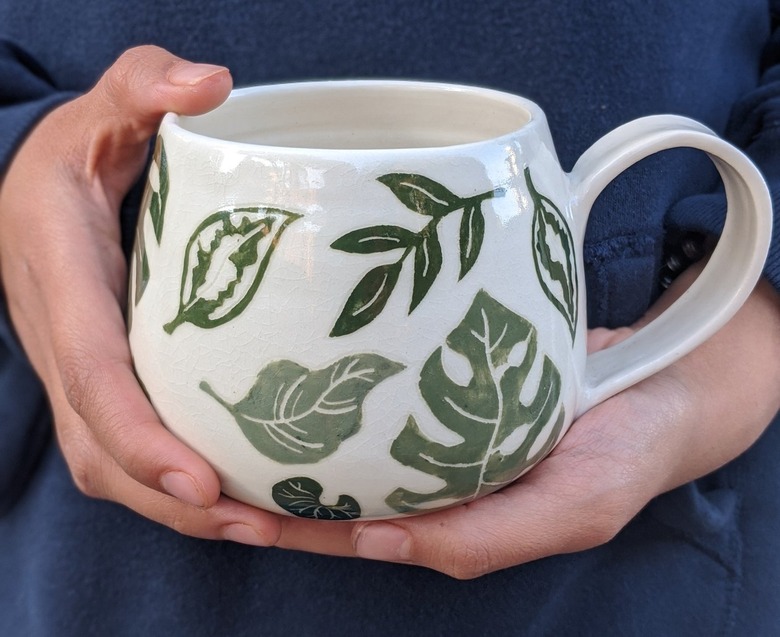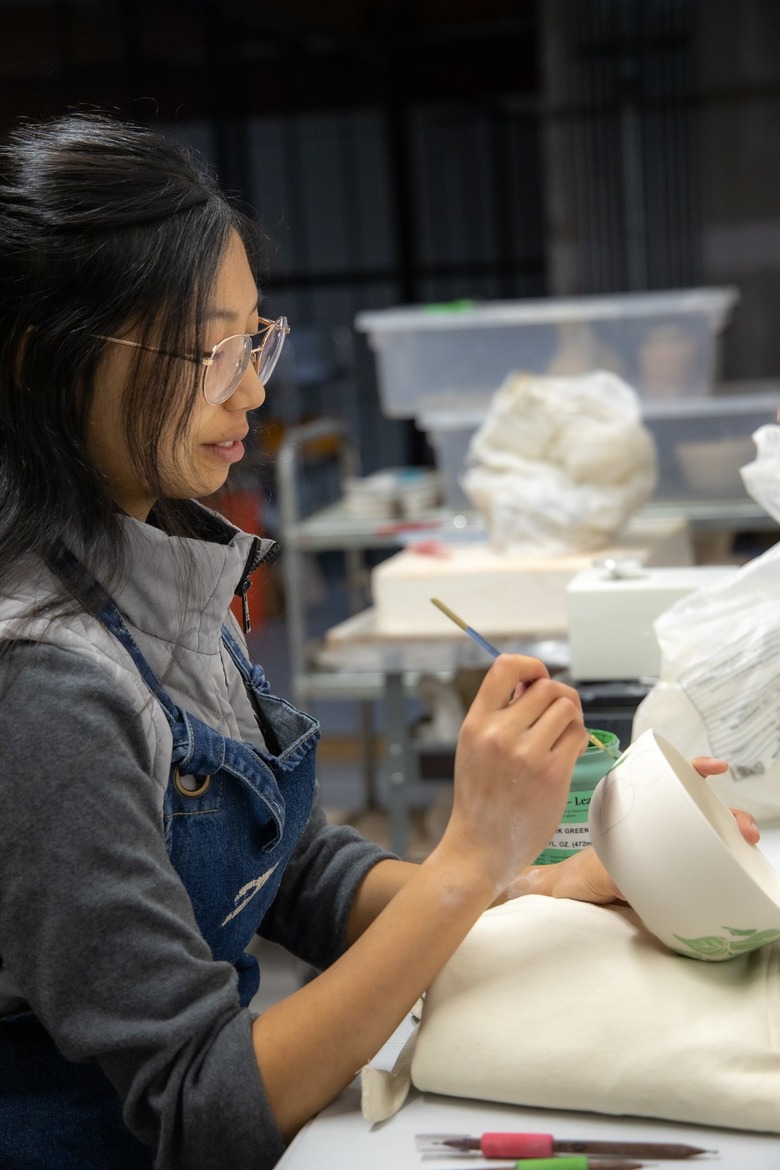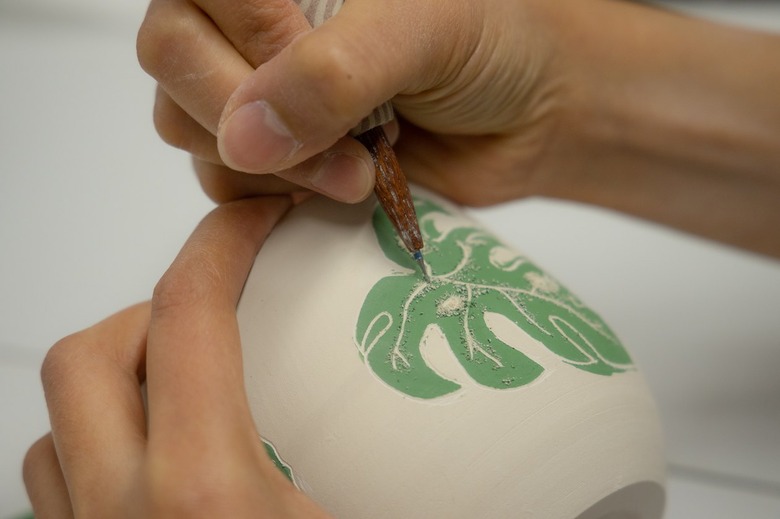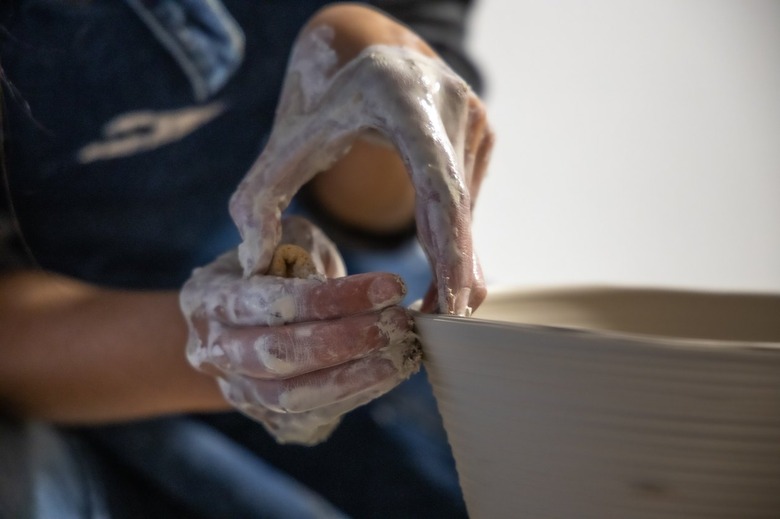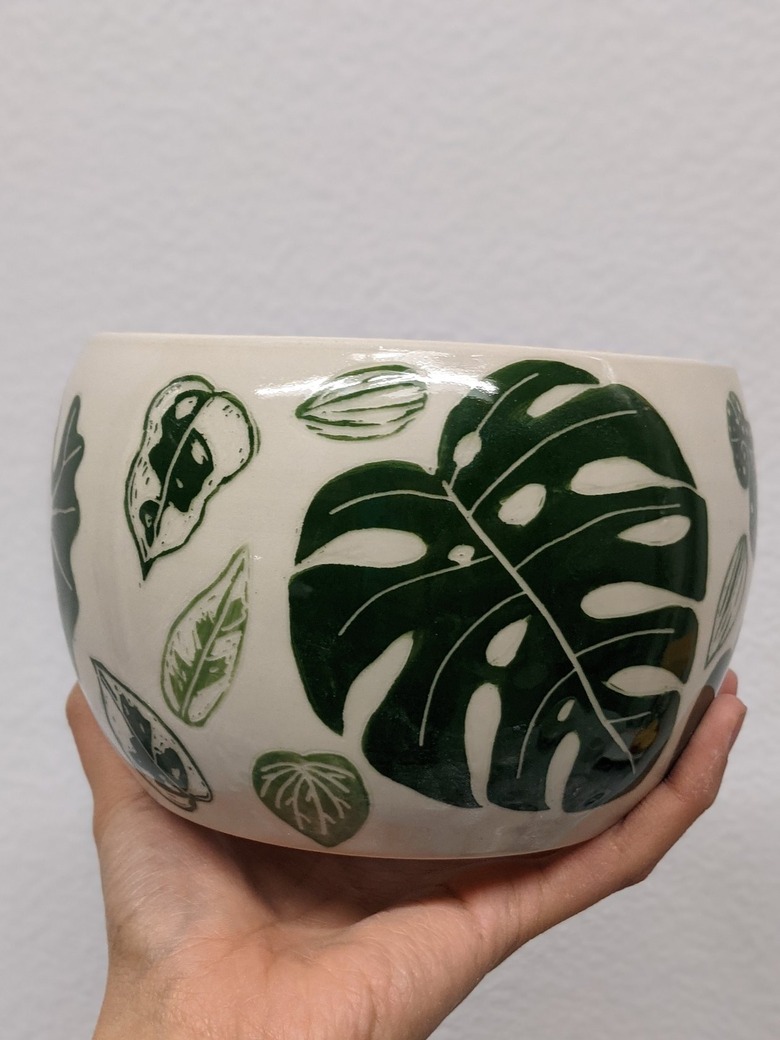Celeste Wong Combines Pottery With A Love Of Plants
Celeste Wong didn't always plan on being an artist. Instead, ceramics found her. She grew up adventuring through nature and learning about plants alongside her father. When she took her first pottery class in college, she found that being behind the wheel actually felt a little bit like home.
The 24-year-old ceramicist based in Hercules, California worked at a pottery studio in Napa for two years learning from a husband-and-wife duo; then, her father, a small business owner, offered her a space in his studio. Her little corner of the loft came to house her wheel and a kiln she found on Craigslist. Despite the COVID-19 pandemic making it difficult to attend art festivals to sell her work, or to get time in other studios, Wong was able to build a following on Instagram. Now, the artist creates plant-inspired works on the wheel, hand-painting leaves and adding painstaking designs like monstera leaves and Sansevieria plants inspired by hikes and her house plants.
Below, Wong tells us more about the importance of experimenting and the power of learning from artists across different mediums.
Hunker: Plants, clearly, inspire your work. What is it about them that makes you want to create?
Celeste Wong: Before I was an art major in college, I actually wanted to study marine biology and environmental science. I knew I wanted to do something in the field of science, something where I knew I could be hands on and be in nature instead of a scientist in the lab. My love for nature and plants and botany really stemmed from when I was a kid, my dad and I had our disposable cameras (back in the day) and went hiking with my guide book and took pictures of flowers. I loved to know all of the flowers' names.
In college, I had plants and I took electives in greenhouse gardening. I was so torn between art and science for a really long time; I tried double majoring, but I know I have a little bit of a learning disability and quite a lot of anxiety, so that was really impairing my ability to take tests. To cope with that, I would doodle every kind of plant diagram from my science book, just drawing all of these little details. My body was telling me I needed this creative outlet, and while I was in the books studying so hard, I was so unhappy. I decided to be an artist full-time because that was what my body was telling me to do. Now, I have so many house plants at home; plants just make me so happy. There's so much to learn from them.
Hunker: How did you get started with pottery?
CW: Pottery was always on my bucket list. When I was browsing through the school catalog, I came across ceramics. I got into [the] class and to my delight, it was wheel-throwing pottery. It was exactly what I wanted to do: to attempt to make something on the potter's wheel. Even though I was terrible at it [laughs] and I failed for a really long time, it was so addictive. The entire process is a very laborious, long process. It could take like, three weeks to a month to get a batch of pieces finished. There's just so many elements that drew me in. There's so much experimentation, and the science part of me was really interested in that — the material of the clay, the firing process, the chemical composition. There are so many variables in how to make a piece. No matter how many hours I'm putting into one thing, I'm always learning.
Hunker: When did you first really consider yourself a potter?
CW: In college, I was trying to figure out my medium. Before that, I would just draw lots of line and ink drawings. Pottery was different in that I could make something functional, which is what I loved the most about pottery as an artwork. It can be sculptural and it can be functional. During my senior year, I decided pottery was what I wanted to do for the rest of my life. I started my Instagram my last year of college and people started asking for commissions. It was a small side hustle. I really felt like I was a potter after college. I had no idea what I was going to do, but I interned with a husband and wife pottery [team] at their studio in Napa called NBC Pottery. They offered me a job after college and I stayed with them for a couple years.
Hunker: You got your BFA in 2018. How do you think your formal education impacted your craft?
CW: Often, I question if I should go to a ceramics college or pottery college because I feel like I don't know that much about pottery [specifically] — there were only three wheel throwing classes that my college had to offer. I feel that having that general background into different mediums really influenced how my work came to be. I really loved line drawing, and being in touch with the different mediums helped me bring that and implement what I like into my pottery.
My pottery is made by me painting on all of these leaves by hand, and then going back and carving all of those little lines. Other potters focus more on the external surface of [the] color, so they'll make a piece and they'll go ahead and fire it once, and then dip it into a color or glaze and then it's done. I love focusing on all of the details and carving onto the clay. I took a class called "Linocut Printmaking" and that medium is one that's really dear to my heart. I do that on the side sometimes; I make prints. You basically carve out a rubber stamp, and then you ink it, and you print. There's so many crossovers with carving there.
Hunker: You've taught beginner ceramics sessions. What does it feel like to teach pottery to others?
CW: It's very humbling. I'm really into psychology, and there's this term called "Master Syndrome" where when you feel like you know you're a master, but when you're teaching, you get mad at the students easily like, "You should know that already." They expect people to know what they know. When I'm teaching, I have to remember what it was like when I was first beginning, and how much I struggled, and to explain everything as basic and from the ground up as possible. Teaching people isn't something everyone can do. When I was first learning, I struggled so hard and then I found a different teacher outside of my college who explained something from a different perspective to where I got it. I don't expect anyone I teach to understand what I'm teaching because maybe it's just not a good match. I love it because when people come out and have a finished product that they're proud of, that's the true warmth [of art]. Seeing people happy with what they've made themselves.
Hunker: Who are your favorite artists?
CW: At this moment, I don't have a particular favorite. You can go back and look at all of the masters of their time, but for me the people who really inspire me today are just the people living now and, too, not necessarily the artists in my medium. Some people are so focused on staying within their medium, but I think it's important to be inspired by every medium and make friends from all sorts of mediums be it sculptors, printmakers, or painters. It broadens your world.
Some artists I admire are Yayoi Kusama, Claude Monet, Ruth Asawa, Katsushika Hokusai, and Georgia O'Keeffe. Specifically in the world of ceramics, I look to Ayumi Horie, Adam Field, Zemer Peled, and Johnson Tsang.
Hunker: How do you stay motivated and inspired to create new work?
CW: I'll definitely be on Instagram and reach out to people who are local or strike up small conversations within the pottery community ... Quite often, we hit it off and bounce ideas off of each other. I've kept in touch with several people from college and ask about art and life. Community is so important for that motivation. The stereotype of artists is like, oh, the starving artist, being alone, and the struggle of being alone and creating art. That's not the way to go. Just finding community within the artists' world and in your own medium is very important. Sharing each others' experiences, whether positive or negative, really keeps you motivated ... since my art is based in nature, I'll go on hikes, and get outside. Nature is such an easy way to heal and change your mindset and, for me, it feels like a reset.
